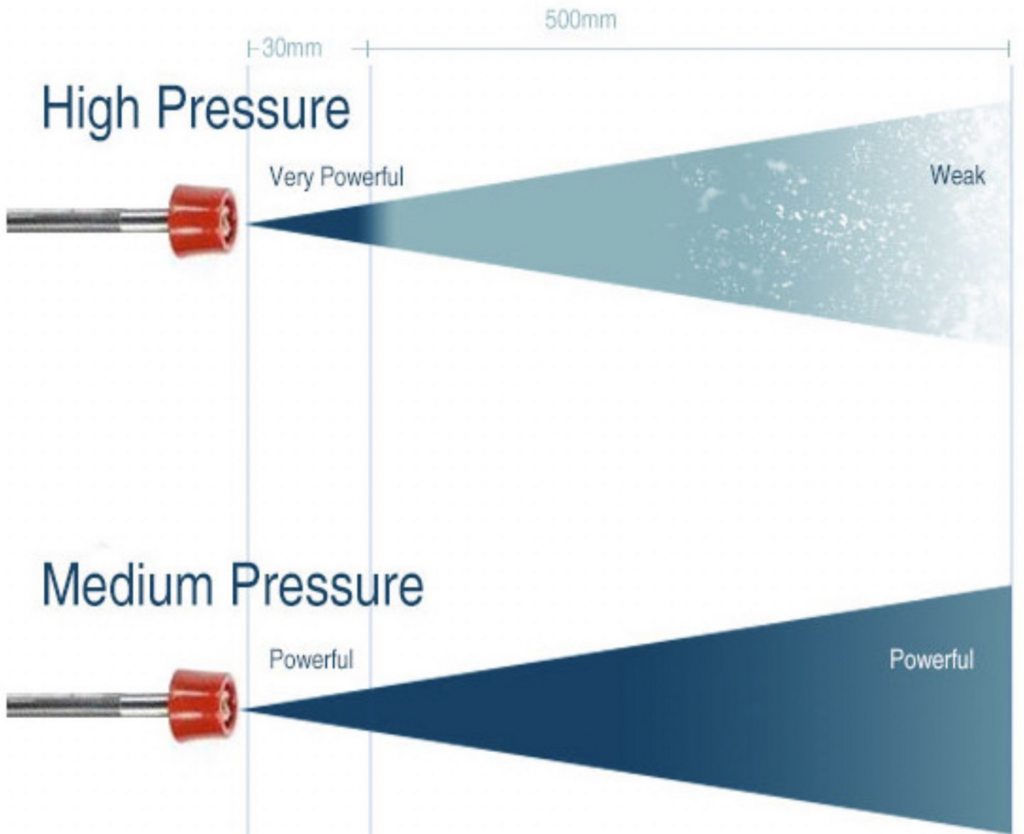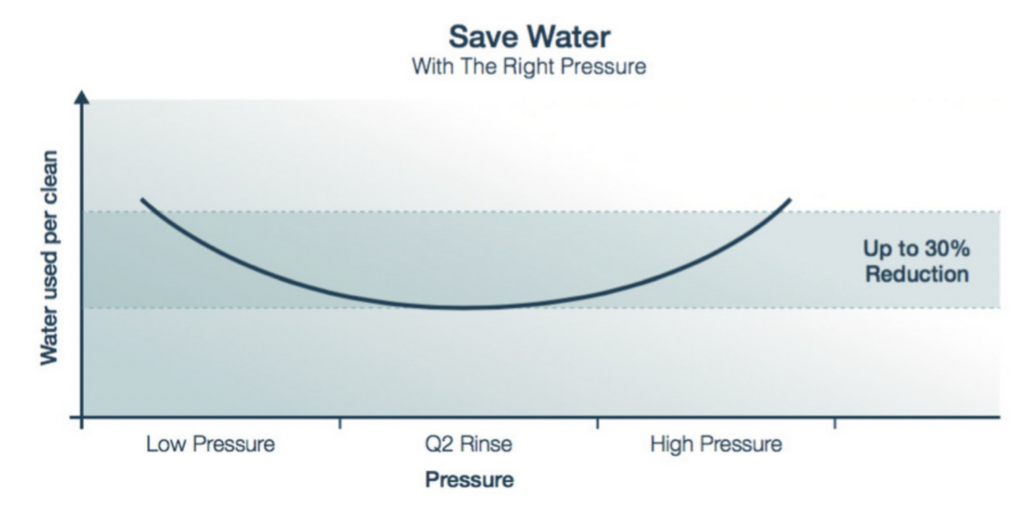So many questions where to start? …. how about the unlikely…..
What Is The Best Rinse Pressure For Cleaning In The Food Industry?
Many hygiene teams have their own view on what the best rinse pressure is for cleaning in the food industry, but what do you think?
Whilst high pressure water produces hazardous aerosols and is inefficient, low pressure also can be very efficient, so where is the happy medium? Here’s a suggestion why Medium Pressure is deemed the better rinse pressure for the food industry:
Why Use Medium Pressure Rinse?
With medium pressure rinse, you can clean faster and better in less time, enabling you to make savings in many areas. It can save food risks, energy, water, effluent, labour, and most of all, money. Read on to find out more, but firstly consider this fact:
A correctly controlled medium pressure jet will maintain its impact over a greater distance than other high pressure jets.
To demonstrate the effectiveness of Medium Pressure, try this simple test:

This diagram shows that with higher pressure wash down, you can only effectively clean a small area at a time. Medium pressure systems, however, can clean a larger area at a time. This is because high pressure jet will lose effectiveness over distance. Research shows that High Pressure Water has a 63% greater impact reduction over distance than that of medium pressure.
- Save Time – Clean more area per minute!
- Save Water Wastage – make sure every drop of water is used to clean!
- Save Aerosol – improve food safety through minimized airborne bacteria
So, in a nutshell – the impact from high pressure water doesn’t go as far as the impact from medium pressure, reducing quality and effectiveness of the cleaning.
YOU can prove it! – Using a high pressure jet, you can observe that the further you go from the dirt you are spraying, the less effective your water jet becomes in cleaning that dirt – that’s easy to understand. And beyond a certain point, it ceases to become effective. But if you did the same with a medium pressure jet, the spray is still effective up to a longer distance from the nozzle.

What Is ‘Medium Pressure’?
At QJS we typically refer to the 3 pressure zones as:
- Low pressure: 3-10 bar
- Medium pressure: 10-40 bar
- High pressure: 40+ bar
Compared to high pressure rinse systems, medium pressure systems can improve:
- Food Safety – Aerosols, over spray and re contamination are majorly reduced
- Operator Safety – Minimized risk of high pressure water injuries
- Water Savings – Highly efficient use of water achieves a quality clean with less water
- Energy Savings – Reduce energy through reduced cleaning time and highly efficient pumps
- Environmental Savings – Reduced carbon footprint through both of the above
- Labour Savings – Efficient washdown gives a faster clean, saving labour, and potentially allowing you more production time.
And also, it helps you meet standards and customer demands – read on for more information.
Why Not Use High Pressure Rinse?
Whilst many sites feel they need very high pressure to clean their factory, high pressure actually has many features which could be you wasting water, time and energy, let alone that it poses some critical food safety risks.
High Pressure can only clean a small area at once, therefore it takes longer to clean your whole factory.
- High Pressure will likely use far more water overall. It may use less water per minute, but to clean an area up to a similar standard compared to medium pressure, you will typically use far more water per clean. Surely this is the more crucial number to look at if you want to save water in your factory cleaning process?
- High Pressure will atomize, creating aerosols which can carry bacteria into the air towards the ceiling and (after a few hours) returning it to the food surfaces which have been cleaned already. Atomized bacteria caused by cleaning has been known to remain present in the air for a whole shift. Is it really worth cleaning your factory if the cleaning results in this?
- High pressure cleaning jets can move dirt back to areas that have already been cleaned – sometimes meaning a factory needs cleaning up to 3 times.
But Why Not Use Low Pressure Rinse? (Below 10 Bar)
The issue with low pressure wash down is that it has a low ‘cleaning ability’. In other words, it cannot ‘cut’ dirt accurately, therefore taking you more time, water, and labour to clean an area effectively.
Low pressure rinse tends to ‘splash back’ and can often require a lot of scrubbing to achieve a satisfactory clean.
What Can Medium Pressure Rinse Do For Me?
In brief, the greatest benefits you can prove are massive in 3 areas: Increased Food Safety, Reducing Water Usage, and Reducing Labour.
- Increased Food safety: As already described, can be improved with medium pressure due to eliminated aerosols and therefore airborne bacteria. Also, medium pressure cleaning reduces splash back and debris movement, ensuring areas already cleaned do not get decontaminated by the rest of the cleaning process.
- Reduced Water Usage: Medium pressure wash down will make effective use of every droplet of water, therefore it can clean with less water. Setting your rinse pressure at between 10 and 30 bar enables you to save water compared to other pressures. You now just need the correct water controls to really make this water effective and ensure you continue to make these water savings in your factory.
- Reduced Labour – Reduce total cleaning time with jets which clean more area per minute. Take a look at the spray diagram at the top of this page to help you understand this concept.
Who Says I Should Use Medium Pressure?
All Auditors will agree that maintaining hygiene and food safety is important within food production areas. However, if you’re washing down in your factory, what water pressure do they recommend?
High pressure hoses are often thought to be the best way, or the only way to clean in some food environments, but many Supermarkets and Auditors prefer to use medium pressure – some examples are below –
Campden BRI: (Researching BRC Issue 7)
‘High pressure air or water results in the movement of debris and dirt. It is important that these actions are controlled as studies have found that high pressure water can transport contamination from point of source as far as 4 m high and 7 m away from the cleaning area. This has the potential to contaminate surfaces of equipment in wide open spaces.’
‘The disadvantages of using high pressure include aerosol production, cross contamination, re contamination, wastage of time and water, and the costs associated with chasing debris to the drain’.
Also: Tesco Food Manufacturing Standards states: ‘Methods of cleaning must not pose a risk of contamination or generate aerosols which could contaminate nearby products or surfaces. High pressure hoses must not be used due to aerosol generation/movement of debris’ (Section 9.7.1)
This is evidence that medium pressure cleaning is by far a better way of complying with customers (supermarkets) and BRC. It is also favored by other supermarket auditors and industry standards.
Contact Sanikleen Group (SGA) for further info at enquiry@sga.com.au
Thanks for reading, stay safe – The SGA Team

![SGA-Logo-White[27599]](https://sga.com.au/wp-content/uploads/2024/03/SGA-Logo-White27599.png)
